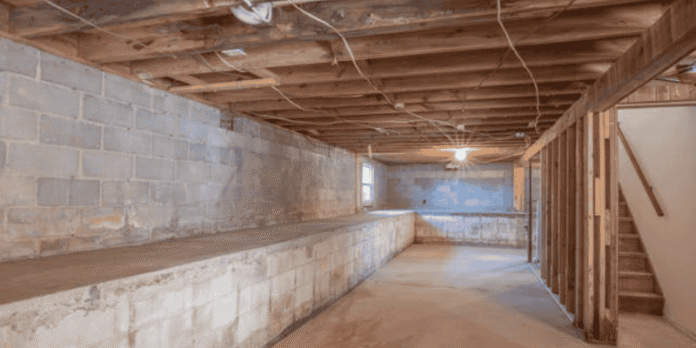Ever head to the basement and find water where your treadmill used to be? You’re not alone. With stronger storms and aging infrastructure, more homes are dealing with leaks, mold, and costly damage below ground. Basements are no longer just storage zones—they’re becoming the front line in a battle against water.
In this blog, we will share how to protect your basement from expensive problems, what warning signs to watch for, and how smart choices now can help you avoid a messy, expensive cleanup later.
Read More: How to Divide a Basement into Multiple Functional Areas
Why Basements Are More at Risk Than Ever
It’s 2025, and the weather isn’t just acting strange—it’s changing the rules entirely. Cities that never worried about flooding are seeing rainfall like never before. That little puddle you ignored last spring? It could turn into several inches of water the next time storms roll through. The ground can only hold so much before it starts pushing the excess back—right into your basement.
More people are finishing their lower levels, turning them into movie rooms, guest suites, or home offices. But when water sneaks in, it doesn’t just leave a damp spot. It ruins floors, soaks drywall, damages furniture, and sometimes wipes out items you can’t replace. And just like that, what was once extra living space becomes a costly disaster zone.
That’s why the best defense starts below your feet. A sump pump is your first line of protection—the quiet, tucked-away machine that keeps water moving out instead of in. But like any system, it isn’t flawless. Parts wear out. Switches fail. Power cuts at the worst time. And when it stops working, the results show fast.
That’s when emergency sump pump repairs can mean the difference between a close call and a full-blown flood. The trick is catching problems before they catch you. Test your pump monthly. Pour water into the pit and listen for it to kick on. If it doesn’t respond, get it checked right away. Even if you’re not the hands-on type, it’s worth bringing in a pro. Because when water starts rising, every second counts—and your basement deserves more than crossed fingers.
The Signs That Trouble Is Brewing
Your basement won’t always give you obvious warnings. Sometimes the signs are subtle. A faint smell. A damp cardboard box. That weird feeling underfoot when walking on the rug. These early clues are your basement trying to speak up.
Watch for cracks in the foundation wall, especially if they widen over time. Stains or discoloration on walls are big red flags. If your dehumidifier is always full, that’s not normal—it’s a sign your space is constantly fighting moisture.
Also, keep an eye on your gutters. If they’re clogged or draining too close to the house, water will find its way down. Sloping your yard away from the foundation helps too. Simple fixes now prevent bigger headaches later.
Another silent threat? Backups from floor drains. Especially in older homes, city sewer systems can send water back the wrong way when overwhelmed. Installing a backwater valve is worth the investment. No one wants to talk about sewage backups, but they’re one of the most expensive types of home water damage to fix.
Smart Upgrades That Pay Off
You don’t need to turn your basement into Fort Knox, but a few smart upgrades can make a huge difference. Start with a backup system for your sump pump. A battery-powered backup or a water-powered model can keep things running if the power goes out.
Water alarms are another underrated tool. These small devices sit on the floor and beep loudly when they detect moisture. They can be the difference between a minor mop-up and a full-blown insurance claim.
If your basement is finished or used often, consider installing a moisture barrier behind drywall. Sealed floors help too. These aren’t cosmetic updates—they’re strategic moves to protect your investment.
French drains or interior drainage systems are great if your home is prone to water issues. They’re more expensive, but they’re a one-time investment that keeps water moving in the right direction: away from your home.
Why You Should Think Like a Home Inspector
Want to really protect your space? Start thinking like the people paid to find problems. Walk your basement regularly. Pretend you’re preparing it for sale. What would a picky buyer or inspector notice?
Check window wells. Are they filling with debris or water? Make sure the covers are intact and sealed. Examine your basement ceiling for leaks from above. That little stain near a pipe could be the start of something bigger.
Pull out old boxes and bins. Look behind shelves. A forgotten corner is often where the first signs of trouble begin. And keep records. When did you last test the pump? Replace the battery? Install the dehumidifier? Treat your basement like the investment it is.
What This Says About How We Treat Our Homes
There’s something bigger going on here. For years, homes were seen as places to show off. Open-concept kitchens. Smart home gadgets. But that mindset is changing. The new trend? Function over flash.
People are investing in protection, not just polish. They’re realizing that what’s below the surface often matters more than what’s on display. A solid foundation, a dry basement, a working sump system—these aren’t glamorous. But they’re what keep the lights on and the costs down.
Even the housing market is shifting. Buyers are asking about water damage history and flood zones. A dry, protected basement is now a major selling point. And for current homeowners, it’s peace of mind you can’t put a price on.
A Little Maintenance Goes a Long Way
You don’t need to spend thousands today. But you do need a plan. Create a basement checklist. Schedule seasonal checks. Talk to your plumber or contractor. Don’t wait until water is already where it shouldn’t be.
If your area has been hit by more storms lately, take that as a warning. Even homes outside traditional flood zones are getting hit. Adaptation is the name of the game now. The homeowners who prepare are the ones who avoid the worst.
Your basement might not be the most exciting part of your home. But it’s often the one that saves you the most money—if you pay attention to it. Listen to the signs. Watch the weather. And don’t let a simple fix turn into a costly surprise.

